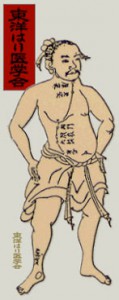Precise palpation skills:
Treatment is largely based on the practitioner’s ability to feel and work with qi throughout the patient’s body. In accordance with tradition, Toyohari employs the “four diagnoses” (asking, looking, listening and touching), and focuses on discerning imbalances in particular along the twelve main circulating channels or meridians. Pulse diagnosis, whilst still based on simple and systematic traditional principles, is taken to an unusually high level, and other areas are also considered during palpatory diagnosis (particularly the hara or abdomen).
Influence of blind practitioners:
Its gentle approach, which particularly emphasizes touch in diagnosis, reflects the general approach to acupuncture in a country which has been uniquely influenced by a four-hundred year old tradition of blind acupuncture practitioners. The founders of the Toyohari Association, as well as most of its current senior practitioners were and are blind or visually impaired.
Gentle, precise techniques:
Practitioners use specialised needle techniques unique to Toyohari, which are very gentle and non-invasive. These include a variety of specific techniques for supplementation and dispersion, and use superfine needles, particularly silver needles for supplementation. What is often of most interest to western acupuncturists is the fact that most of the techniques can be very effectively learnt and used non-insertively. Treatment effects are both subtle and strong, and can also be carefully controlled.
Pulse feedback:
Progress during each treatment is carefully monitored point by point by checking changes in the state of the patient’s qi, with treatment continuously adjusted to suit.
Toyohari also adopts the principle, originating from the Nanjing, that, for needling to be effective it is not necessary for the patient to experience heavy sensations from the needling (often called deqi), something which can be characteristic of other styles of practice. In contrast, it is emphasised that the practitioner should feel the qi which makes for a vastly different experience for the patient.
Effective symptom control:
In addition specific and unique supportive treatment techniques have been developed for controlling or targeting symptoms. These include using the Eight Extraordinary Vessels (kikei), the inguinal, sacral and neck and shoulder regions (naso/muno), and supplementation through Midday/Midnight associations (shigo).
Unique continuing learning model:
Something which is unique to the Toyohari approach is the use of the “Kozato Method” for small peer-group learning. Using this, practitioners’ diagnostic abilities are continuously improved by consensus experiential learning, as individual needle techniques are fed back through real-time monitoring of the patient’s pulse. This makes for a dynamic and empowering constant improvement in skills. Such an approach has been shown to create exciting learning curves for the new comer to Toyohari which can often be revelatory, providing a window to an awareness of acupuncture practice which previously seems only to have been accessible to a gifted few.

